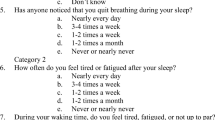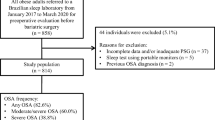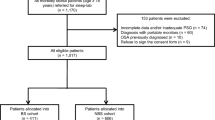Abstract
Background
Obstructive sleep apnea (OSA) is an independent risk factor for complications after surgery. However, OSA remains largely under recognized, and questionnaires designed to detect OSA have shown inconsistent results. Patients with cardiovascular diseases may not present with the typical symptoms of OSA. We therefore sought to compare the performance of screening questionnaires of patients referred for coronary artery bypass grafting (CABG) versus abdominal surgery (Abd surgery).
Methods
We studied 40 consecutive patients referred for CABG [29 men; age 56 ± 7 years; body mass index (BMI) 30 ± 4 kg/m2], and 41 referred to Abd Surgery matched for age, gender, and BMI (28 men; age 56 ± 8 years; BMI 29 ± 5 kg/m2). All patients were evaluated with validated questionnaires to predict OSA (STOP-Bang and Berlin), Epworth sleepiness scale (ESS) and full overnight polysomnography.
Results
The prevalence of OSA (apnea-hypopnea index ≥15 events/hour) in the CABG and Abd surgery groups was similar (52 and 41 %, respectively, p = 0.32). The Berlin questionnaire showed similar sensitivity (67 vs. 82 %, p = 0.17) but lower specificity in the CABG group (26 vs. 62 %, p = 0.02). The STOP-BANG questionnaire had a high sensitivity (90 vs. 94 %, p = 0.42) but low specificity (5 vs. 13 %, p = 0.25) in the CABG and Abd surgery groups, respectively. Patients referred for CABG slept less (323 [285–376] vs. 378 [308–415] minutes, p = 0.04) but had lower levels of daytime sleepiness than Abd surgery patients had (ESS, 6 ± 4 vs. 9 ± 5; p = 0.01, respectively).
Conclusions
Presenting clinical characteristics of OSA are modulated by the population evaluated and may affect the performance of screening questionnaires.


Similar content being viewed by others
References
Sleep-related breathing disorders in adults: recommendations for syndrome definition and measurement techniques in clinical research (1999) The Report of an American Academy of Sleep Medicine Task Force. Sleep 22: 667-689
Marin J, Carrizo S, Vicente E, Agusti A (2005) Long-term cardiovascular outcomes in men with obstructive sleep apnoea-hypopnoea with or without treatment with continuous positive airway pressure: an observational study. Lancet 365(9464):1046–1053
Tufik S, Santos-Silva R, Taddei J, Bittencourt L (2010) Obstructive sleep apnea syndrome in the Sao Paulo Epidemiologic Sleep Study. Sleep Med 11:441–446
Young T, Finn L, Peppard P, Szklo-Coxe M, Austin D, Nieto J, Stubbs R, Hla K (2008) Sleep disordered breathing and mortality: eighteen-year follow-up of the Wisconsin Sleep Cohort. Sleep 31:1071–1078
Hwang D, Shakir N, Limann B, Sison C, Kalra S, Shulman L, Souza Ade C, Greenberg H (2008) Association of sleep-disordered breathing with postoperative complications. Chest 133:1128–1134
Memtsoudis S, Liu SS, Ma Y, Chiu YL, Walz JM, Gaber-Baylis LK, Mazumdar M (2011) Perioperative pulmonary outcomes in patients with sleep apnea after noncardiac surgery. Anesth Analg 112:113–121
Gupta RM, Parvizi J, Hanssen AD, Gay PC (2001) Postoperative complications in patients with obstructive sleep apnea syndrome undergoing hip or knee replacement: a case-control study. Mayo Clin Proc 76:897–905
Kaw R, Pasupuleti V, Walker E, Ramaswamy A, Foldvary-Schafer N (2012) Postoperative complications in patients with obstructive sleep apnea. Chest 141:436–441
Kaw R, Chung F, Pasupuleti V, Mehta J, Gay PC, Hernandez AV (2012) Meta-analysis of the association between obstructive sleep apnoea and postoperative outcome. Br J Anaesth 109:897–906
Young T, Evans L, Finn L, Palta M (1997) Estimation of the clinically diagnosed proportion of sleep apnea syndrome in middle-aged men and women. Sleep 20:705–706
Finkel KJ, Searleman AC, Tymkew H, Tanaka CY, Saager L, Safer-Zadeh E, Bottros M, Selvidge JA, Jacobsohn E, Pulley D, Duntley S, Becker C, Avidan MS (2009) Prevalence of undiagnosed obstructive sleep apnea among adult surgical patients in an academic medical center. Sleep Med 10:753–758
Netzer N, Stoohs R, Netzer C, Clark K, Strohl K (1999) Using the Berlin questionnaire to identify patients at risk for the sleep apnea syndrome. Ann Intern Med 131:485–91
Chung F, Yegneswaran B, Liao P, Chung SA, Vairavanathan S, Islam S, Khajehdehi A, Shapiro CM (2008) STOP questionnaire: a tool to screen patients for obstructive sleep apnea. Anesthesiology 108:812–821
Joshi GP, Ankichetty SP, Gan TJ, Chung F (2012) Society for Ambulatory Anesthesia consensus statement on preoperative selection of adult patients with obstructive sleep apnea scheduled for ambulatory surgery. Anesth Analg 115:1060–8
Gross JB, Bachenberg KL, Benumof JL et al (2006) Practice guidelines for the perioperative management of patients with obstructive sleep apnea: a report by the American Society of Anesthesiologists Task Force on Perioperative Management of patients with obstructive sleep apnea. Anesthesiology 104:1081–1093
Chung F, Subramanyam R, Liao P, Sasaki E, Shapiro C, Sun Y (2012) High STOP-Bang score indicates a high probability of obstructive sleep apnoea. Br J Anaesth 108:768–775
Danzi-Soares NJ, Genta PR, Nerbass FB, Pedrosa RP, Soares FS, Cesar LA, Drager LF, Skomro R, Lorenzi-Filho G (2012) Obstructive sleep apnea is common among patients referred for coronary artery bypass grafting and can be diagnosed by portable monitoring. Coron Artery Dis 23:31–38
Montemurro LT, Floras JS, Millar PJ, Kasai T, Gabriel JM, Spaak J, Coelho FM, Bradley TD (2012) Inverse relationship of subjective daytime sleepiness to sympathetic activity in heart failure patients with obstructive sleep apnea. Chest 142:122–8
Arzt M, Young T, Peppard PE, Finn L, Ryan CM, Bayley M, Bradley TD (2010) Dissociation of obstructive sleep apnea from hypersomnolence and obesity in patients with stroke. Stroke 41:e129–134
Drager L, Genta PR, Pedrosa R, Nerbass F, Gonzaga C, Krieger E, Lorenzi-Filho G (2010) Characteristics and predictors of obstructive sleep apnea in patients with systemic hypertension. Am J Cardiol 105:1135–1139
Lang RM, Bierig M, Devereux RB et al (2006) Recommendations for chamber quantification. Eur J Echocardiogr 7:79–108
Grundy SM, Cleeman JI, Daniels SR, Donato KA, Eckel RH, Franklin BA, Gordon DJ, Krauss RM, Savage PJ, Smith SC, Spertus JA, Costa F (2005) Diagnosis and management of the metabolic syndrome: an American Heart Association/National Heart, Lung, and Blood Institute scientific statement: executive summary. Crit Pathw Cardiol 4:198–203
Stone NJ, Bilek S, Rosenbaum S (2005) Recent National Cholesterol Education Program Adult Treatment Panel III update: adjustments and options. Am J Cardiol 96:53E–59E
Johns M (1991) A new method for measuring daytime sleepiness: the Epworth sleepiness scale. Sleep 14:540–545
Redline S, Budhiraja R, Kapur V, Marcus CL, Mateika JH, Mehra R, Parthasarthy S, Somers VK, Strohl KP, Sulit LG, Gozal D, Wise MS, Quan SF (2007) The scoring of respiratory events in sleep: reliability and validity. J Clin Sleep Med 3:169–200
Drager LF, Bortolotto LA, Maki-Nunes C, Trombetta IC, Alves MJ, Fraga RF, Negrão CE, Krieger EM, Lorenzi-Filho G (2010) The incremental role of obstructive sleep apnoea on markers of atherosclerosis in patients with metabolic syndrome. Atherosclerosis 208:490–495
Chung F, Ward B, Ho J, Yuan H, Kayumov L, Shapiro C (2007) Preoperative identification of sleep apnea risk in elective surgical patients, using the Berlin questionnaire. J Clin Anesth 19:130–134
Sert-Kuniyoshi FH, Zellmer MR, Calvin AD, Lopez-Jimenez F, Albuquerque FN, van der Walt C, Trombetta IC, Caples SM, Shamsuzzaman AS, Bukartyk J, Konecny T, Gami AS, Kara T, Somers VK (2011) Diagnostic accuracy of the Berlin questionnaire in detecting sleep-disordered breathing in patients with a recent myocardial infarction. Chest 140:1192–1197
Mulley A (1995) Health maintenance and the role of screening. In: Goroll AH ML, Mulley AG (eds) Primary Care Medicine. Lippincott, Philadelphia, pp 13–16
Yumino D, Tsurumi Y, Takagi A, Suzuki K, Kasanuki H (2007) Impact of obstructive sleep apnea on clinical and angiographic outcomes following percutaneous coronary intervention in patients with acute coronary syndrome. Am J Cardiol 99:26–30
Chung F, Yegneswaran B, Liao P, Chung SA, Vairavanathan S, Islam S, Khajehdehi A, Shapiro CM (2008) Validation of the Berlin questionnaire and American Society of Anesthesiologists checklist as screening tools for obstructive sleep apnea in surgical patients. Anesthesiology 108:822–830
Acknowledgements
We acknowledged the help of professionals from the Sleep Laboratory of Heart Institute (InCor), University of São Paulo Medical School, for the help in the conduct of the study.
Conflict of interest
None declared.
Funding
This work was supported by institutional funding only provided by FAPESP (Fundação de Amparo à Pesquisa do Estado de São Paulo).
Author information
Authors and Affiliations
Corresponding author
Rights and permissions
About this article
Cite this article
Nunes, F.S., Danzi-Soares, N.J., Genta, P.R. et al. Critical evaluation of screening questionnaires for obstructive sleep apnea in patients undergoing coronary artery bypass grafting and abdominal surgery. Sleep Breath 19, 115–122 (2015). https://doi.org/10.1007/s11325-014-0971-3
Received:
Revised:
Accepted:
Published:
Issue Date:
DOI: https://doi.org/10.1007/s11325-014-0971-3




